Dahi-wale chatpate alu and babbroo
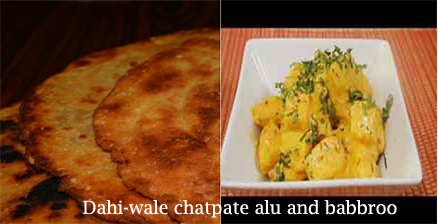
During festivals, Dogra people in Jammu do not fry puris or bhaturas. They indulge in babbroos, which are made from wheat (and not maida) and go well with dahi-wale chatpate alu. For babbroo, you need to knead flour with little yeast, salt and dry coriander seeds. Set it aside for a couple of hours.
Take boiled potatoes and cut them into pieces with hands. Heat mustard oil in a pan (Dogra cuisine is mostly cooked in mustard oil). Add dry whole red chillies, cumin seeds, asafoetida powder, followed by grated ginger and turmeric powder. Then add two big grated tomatoes and let the mixture cook on low heat. Once tomatoes are cooked, add potatoes and sprinkle some dry mango powder/ chat masala, red chilli powder and salt. Beat one cup of curd and pour it on the potatoes. Mix well and cover the pan for 10 minutes. Dahi-wale-chatpate-alu is ready.
Finally, fry the babbroos. Dogra women do not use a rolling pin and make round shaped babbroos with their hands (apply little oil on your hands).
Saant meal: Rajma, ambal, chana dal and rice
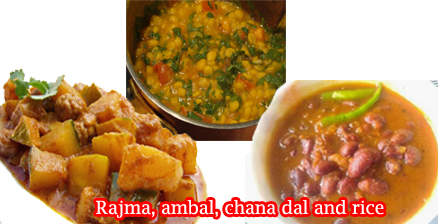
Jammu�s rajma-chawal (red beans and rice) are world famous. Dogra weddings are incomplete without serving rajma to the guests. On the day of saant (haldi ceremony), the lunch menu is rajma, ambal and rice.
Soak rajma overnight by adding salt and asafoetida powder. Boil them in the morning. Grate ginger and tomatoes separately. Heat mustard oil in a karahi (deep cooking-pot) and add these whole masala � bay leaf, cumin seeds, dry red chilli, black cardamom, clove. Then add turmeric powder and grated ginger, and let it cook. Add grated tomatoes, red chilli powder and coriander powder. Cover the karahi and let it cook on low heat. Add boiled rajma (not the water) and mix it well, while mashing the rajma softly with a ladle. Finally add water and salt, and let rajma cook on low heat. For tadka (tempering), heat ghee (clarified butter) in a small pan, add asafoetida powder and red chilli powder, and immediately pour it over the rajma.
Ambal, a sweet and sour recipe, is unique to Jammu region and is a must during all festivities. Peel and cut pumpkin (yellow) into pieces. Heat mustard oil in karahi, and add fenugreek seeds, asafoetida powder, dry red chillies and turmeric powder. Add pumpkin to it and cook them for sometime till they become soft. Make a paste of tamarind with water and slowly add it to the karahi. As it simmers, add jaggery to it and let the mixture cook on low flame. Serve hot ambal with rajma, chana dal (Bengal gram split and skinned) and rice. Dogra community cooks chana dal by adding saunf (fennel seeds) to it.
Winter lunch: Kulath ki khatti dal and rice
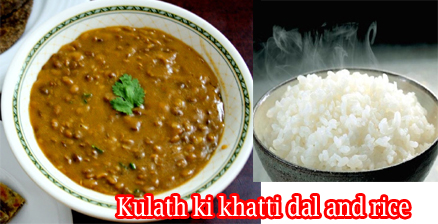
Soak kulath dal (horse gram) overnight by adding salt and asafoetida powder. Boil it on low heat for 45 mins or more in the morning. Mash boiled kulath softly with a ladle. Make a thick paste of tamarind and water. Heat ghee in a karahi and add asafoetida powder, dry red chillies, red chilli powder and turmeric powder. Pour kulath dal in it. Keep adding tamarind paste while the dal simmers. Let kulath cook on low flame for 15 minutes. Serve hot with rice. Kulath is best natural remedy for stones in the kidneys and gall bladder.
Traditional Dogra meal: Madra and rice
Madra is a traditional spicy yogurt-based recipe. It can be cooked with chana, rajma, urad dal or raungi. Soak chickpeas overnight and boil them in the morning. Separately, soak 1/4 cup rice in one cup water and a cardamom. Grind this mixture and keep aside.
Heat mustard oil in a karahi. Add asafoetida powder, cumin seeds, cinnamon, cloves, black cardamom, coriander powder and turmeric powder. Add boiled chickpeas and salt, and stir well. Beat two cups of curd and add to karahi, stirring continuously for 10 minutes on medium heat. When it comes to boil, add rice mixture to it and stir. Finally add 2-3 spoons of ghee and let it cook on low heat for half an hour. Serve madra hot with rice.
Snacks: Pattode and chutney
Pattode are made from leaves of arbi (colocasia) or kachalu (taro). Wash the leaves properly. Make a thick paste of besan (gram flour), water, red chilli powder, chopped green chillies, cumin seeds and salt. Take one full leaf and keep it upside down. Apply besan paste on the backside of the leaf. Put another leaf, upside down, on the first leaf smeared with besan paste. Cover the backside of second leaf with the paste. Put third leaf on it, covering its backside with paste, followed by a fourth leaf. Roll this stack of leaves and close it with toothpicks. Steam these rolls or fry them. Cut them and serve hot with green chutney.
Kalari
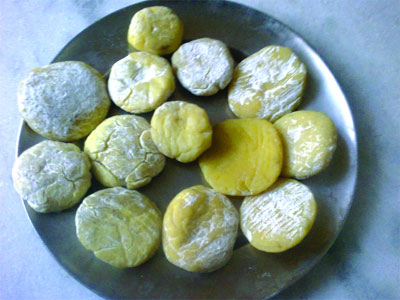
Kalari is a traditional ripened cheese product indigenous to Udhampur, Jammu province of Jammu and Kashmir state of India.[1] It is a very dense cheese that is usually saut�d in its own fat and salted while serving. Kalaris are usually made from cow's or buffalo's milk, though kalaris made from goat's milk are also available, and have a whitish color.[2] Traditionally Kalaris are made from rawm(uncooked) full fat milk that is separated using soured milk. The solidified part is paced in doonas (small bowls made of leaves) and sun dried. The excess liquid drips down from the semi porous doonas and rest of the moisture is lost by sun drying. As the ambient temperature is low and the sun is strong in the mountains, the Kalari becomes dry from outside yet retains moisture from inside. Some times fungus grows on this and gives it a unique flavour.
Kyuur
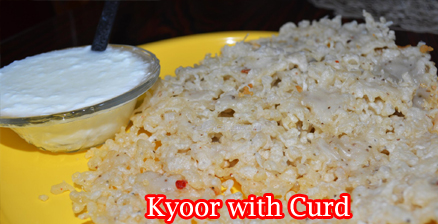
Kyuur, prepared with maida, is another authentic dish of Jammu. It is an important item in Dogra weddings and is considered auspicious to fed bridegroom and bride
Overview
Nai Basti Gulabgarh village came into existence after partition of the country. Hindu population of Gulbgarh migrated to the present location which was named as Nai Basti Gulabgarh by the community that migrated to Indian side.
Contact Us
Name: H.C. Katoch
Telephone: 9622227700
General Secretary , SEEAS Jammu
 Rural Tourist Village
Rural Tourist Village 






